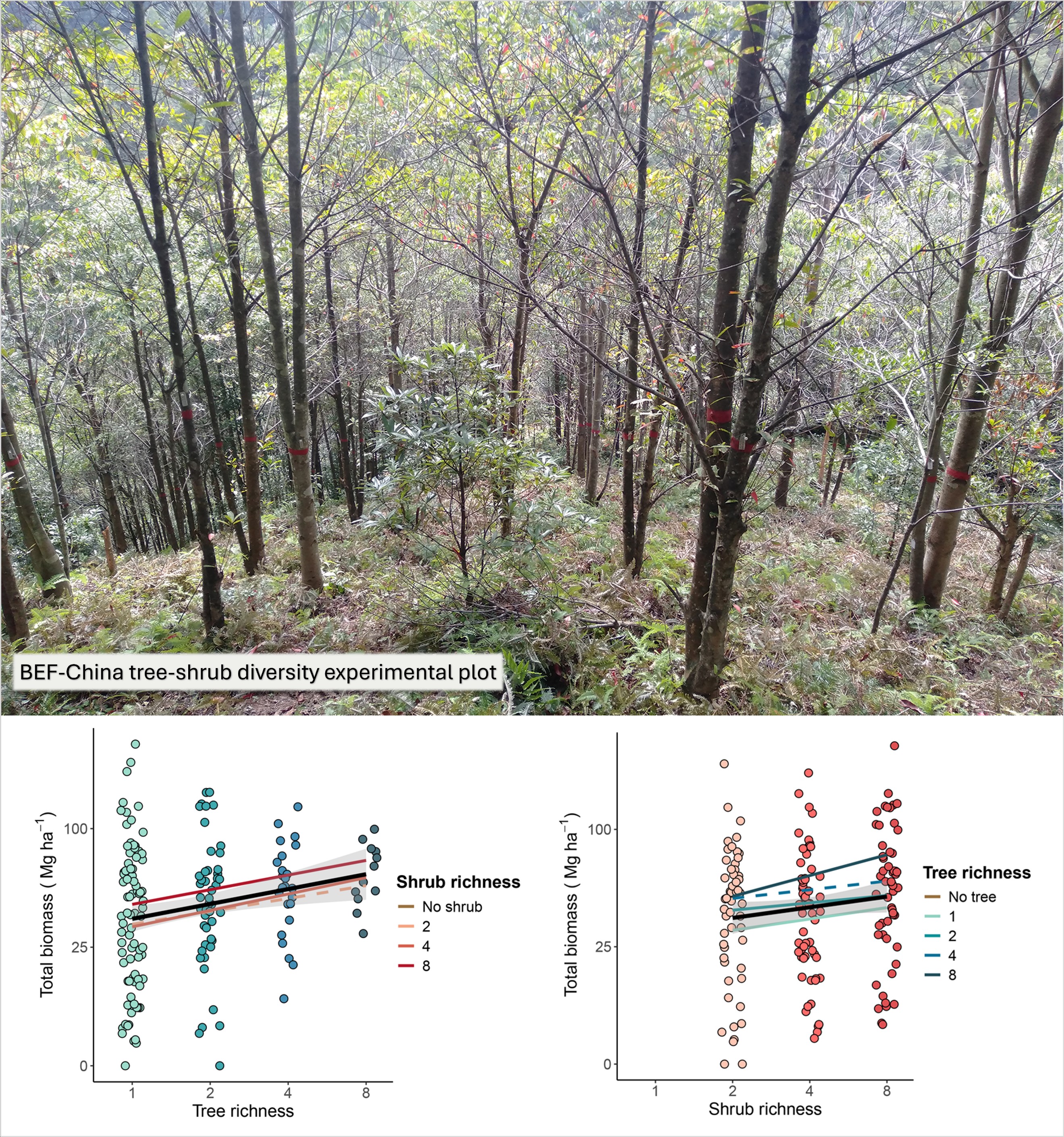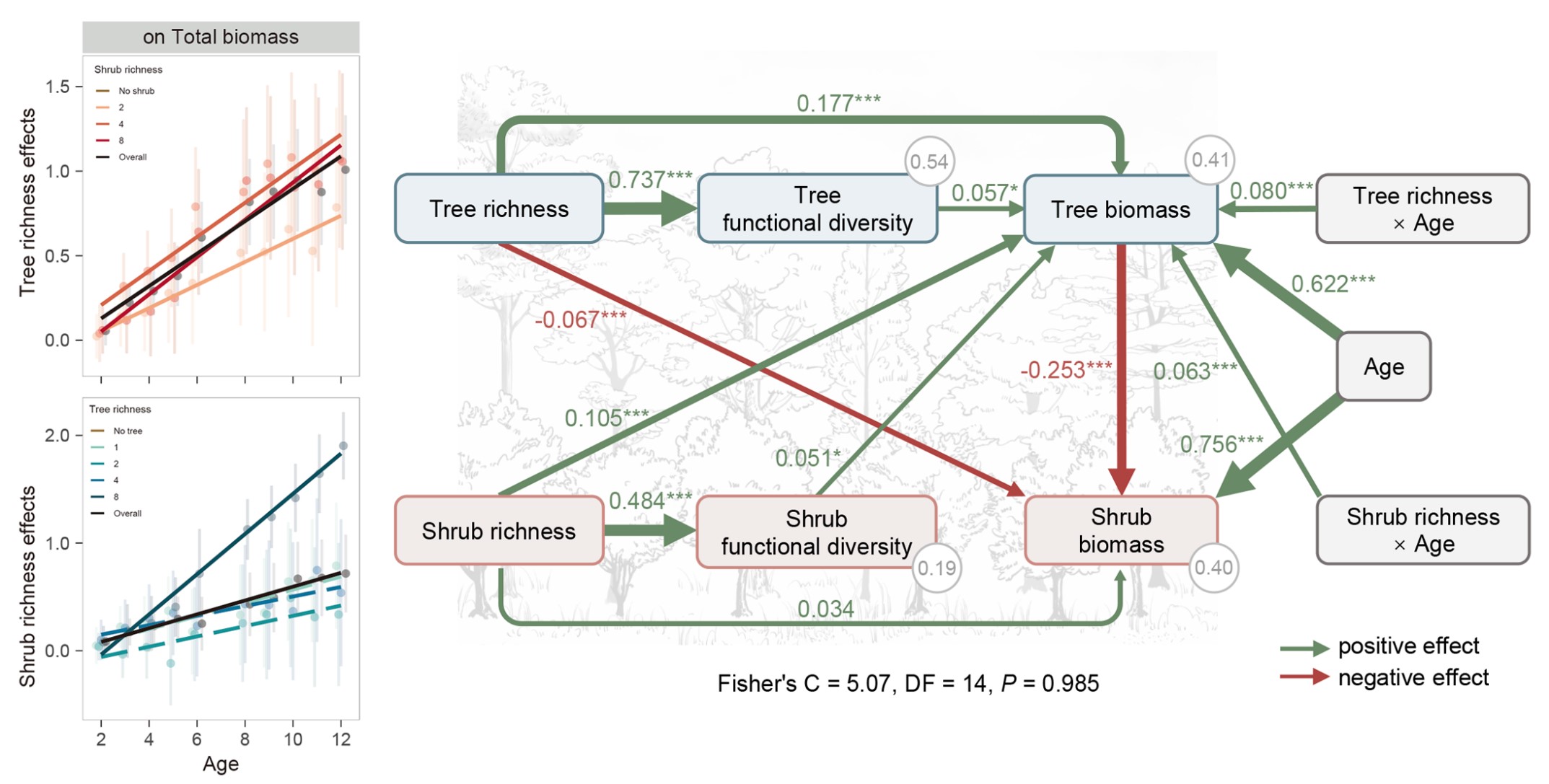In a recent study published in National Science Review, an international research team led by Prof. Xiaojuan Liu from the Institute of Botany at the Chinese Academy of Sciences (IBCAS) has uncovered the critical yet often overlooked role of shrub diversity in enhancing forest ecosystem functioning. This 11-year data of a forest biodiversity experiment has provided compelling evidence that shrubs, typically considered secondary to trees, are just as vital in sustaining forest productivity as the overstory tree layer, challenging the traditional focus on trees and demonstrating their equal importance for healthy ecosystems.
The study examined how the diversity of trees and shrubs affects forest productivity by varying the number of species in both layers and analyzing their growth over time. The results revealed that increasing shrub richness from two to eight species promoted tree biomass by 53.8% and total woody biomass by 37.1%. Comparatively, increasing tree richness over the same range enhanced tree biomass by 73.3% and total woody biomass by 46.8%. These findings highlight that the shrub richness plays a role almost as important as tree richness in supporting forest productivity.
Over time, the benefits of greater tree and shrub diversity became even more apparent, suggesting that their richness contributes to long-term ecosystem functioning. However, the study also noted a slight trade-off: higher tree richness slightly reduced shrub biomass, indicating a complex interplay between the two layers. The researchers linked these effects, in part, to greater functional diversity—the variety of ecological roles played by different species—in both the tree and shrubs.
This research has important implications for forest restoration and management. While traditional efforts have prioritized tree planting and diversity, the study emphasizes that a diverse shrub layer is equally critical for maintaining ecosystem productivity. Neglecting shrub diversity in restoration projects could undermine long-term forest ecosystem functioning.

Figure 1. The effects of tree and shrub richness on total woody biomass in BEF-China experiment. (Plot image by LIU Xiaojuan; Line chart by CHEN Chen & LIU Xiaojuan)

Figure 2. Pathways and temporal variation of tree and shrub richness effects on forest biomass. (Image by CHEN Chen & LIU Xiaojuan)
In a recent study published in National Science Review, an international research team led by Prof. Xiaojuan Liu from the Institute of Botany at the Chinese Academy of Sciences (IBCAS) has uncovered the critical yet often overlooked role of shrub diversity in enhancing forest ecosystem functioning. This 11-year data of a forest biodiversity experiment has provided compelling evidence that shrubs, typically considered secondary to trees, are just as vital in sustaining forest productivity as the overstory tree layer, challenging the traditional focus on trees and demonstrating their equal importance for healthy ecosystems.
The study examined how the diversity of trees and shrubs affects forest productivity by varying the number of species in both layers and analyzing their growth over time. The results revealed that increasing shrub richness from two to eight species promoted tree biomass by 53.8% and total woody biomass by 37.1%. Comparatively, increasing tree richness over the same range enhanced tree biomass by 73.3% and total woody biomass by 46.8%. These findings highlight that the shrub richness plays a role almost as important as tree richness in supporting forest productivity.
Over time, the benefits of greater tree and shrub diversity became even more apparent, suggesting that their richness contributes to long-term ecosystem functioning. However, the study also noted a slight trade-off: higher tree richness slightly reduced shrub biomass, indicating a complex interplay between the two layers. The researchers linked these effects, in part, to greater functional diversity—the variety of ecological roles played by different species—in both the tree and shrubs.
This research has important implications for forest restoration and management. While traditional efforts have prioritized tree planting and diversity, the study emphasizes that a diverse shrub layer is equally critical for maintaining ecosystem productivity. Neglecting shrub diversity in restoration projects could undermine long-term forest ecosystem functioning.

Figure 1. The effects of tree and shrub richness on total woody biomass in BEF-China experiment. (Plot image by LIU Xiaojuan; Line chart by CHEN Chen & LIU Xiaojuan)

Figure 2. Pathways and temporal variation of tree and shrub richness effects on forest biomass. (Image by CHEN Chen & LIU Xiaojuan)
